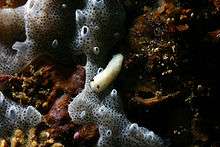Cadlina flavomaculata
Cadlina flavomaculata, common name the yellow-spot cadlina, is a species of colourful sea slug, a dorid nudibranch, a shell-less marine gastropod mollusk in the family Cadlinidae.[3][4]
| Yellow-spot cadlina | |
|---|---|
 | |
| Cadlina flavomaculata from Point Pinos, California | |
| Scientific classification | |
| Kingdom: | Animalia |
| Phylum: | Mollusca |
| Class: | Gastropoda |
| Subclass: | Heterobranchia |
| Order: | Nudibranchia |
| Suborder: | Doridina |
| Superfamily: | Doridoidea |
| Family: | Cadlinidae |
| Genus: | Cadlina |
| Species: | C. flavomaculata |
| Binomial name | |
| Cadlina flavomaculata | |
Distribution
Cadlina flavomaculata is a relatively rare nudibranch found in subtidal and intertidal zones of the northeastern Pacific, from Vancouver Island to the southern tip of Baja California. However, it is common in some diving sites between Monterey, Carmel and Big Sur.[5]
Description
The yellow-spot cadlina is charactered by its ovate, translucent, white mantle with distinctive, brown to black rhinophores. A series of large, yellow spots (mantle glands) can be seen on each side of the mantle. Some reported specimens also show a yellow border to the mantle, but this is not found in all individuals. The color of branchia (gills) is white to yellow.[6] Its reported length is 15 mm.[7][8][9][10]
Ecology

Cadlina flavomaculata feeds on the sponge Aplysilla glacialis.[11]
References
- MacFarland, Frank Mace (1905) A preliminary account of the Dorididae of Monterey Bay, California. Proceedings of the Biological Society of Washington, 18: 35-54.
- MacFarland, Frank Mace (1906) Opisthobranchiate Mollusca from Monterey Bay, California, and vicinity. Bulletin of Fisheries, 25: 109-151.
- Caballer, M. (2011). Cadlina flavomaculata McFarland, 1905. Accessed through: World Register of Marine Species on 2011-02-26
- Johnson R.F. (2011) Breaking family ties: taxon sampling and molecular phylogeny of chromodorid nudibranchs (Mollusca, Gastropoda). Zoologica Scripta 40(2): 137-157. page(s): 139
- McDonald, G. R. (1983). A review of the nudibranchs of the California coast. Malacologia 24 (1-2): 114-276.
- Behrens, D.W. and A. Hermosillo 2005. Eastern Pacific Nudibranchs: A guide to the Opisthobranchs from Alaska to Central America. Sea Challengers. Monterey, CA. 137 p.
- Behrens, David W. 1991. Pacific coast nudibranchs. Sea Challengers, Monterey, CA, 105 pp.
- Debelius, H. & Kuiter, R.H. (2007) Nudibranchs of the world. ConchBooks, Frankfurt, 360 pp. ISBN 978-3-939767-06-0 page(s): 213
- Cadlina flavomaculata. Miller, M. ed., accessed 2018-12-04.
- Rudman, W.B., 2005 (August 19) Cadlina flavomaculata MacFarland, 1905. [In] Sea Slug Forum. Australian Museum, Sydney.
- McDonald, G. R.; Nybakken, J. R. (1978). "Additional notes on the food of some California nudibranchs with a summary of known food habits of California species". The Veliger. 21 (1): 110–118.